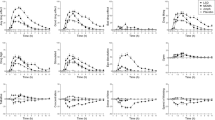Abstract
THE compound 6-hydroxydopamine (6-OHDA) produces a long-lasting depletion of brain noradrenaline (NA) and dopamine (DA) when injected into the lateral ventricle of the rat brain1. This treatment also results in a reduction in the activities of the catecholamine biosynthetic enzymes, tyrosine hydroxylase and DOPA decarboxylase, in the hypothalamus and corpus striatum. In addition there is a marked reduction in the rate of uptake of 3H-NA into tissue slices from these regions1. These findings are consistent with the evidence from morphological studies2,3 which suggest that the compound causes an acute degeneration of adrenergic nerve terminals in the sympathetic nervous system when admioistered systemically. The effects of 6-OHDA in the CNS are restricted to NA and DA containing neurones, and there is no recovery for periods of up to 142 days after treatment1. The doses of 6-OHDA injected into the brain are not sufficiently large to have any effects on the peripheral sympathetic nervous system2.
This is a preview of subscription content, access via your institution
Access options
Subscribe to this journal
Receive 51 print issues and online access
$199.00 per year
only $3.90 per issue
Buy this article
- Purchase on Springer Link
- Instant access to full article PDF
Prices may be subject to local taxes which are calculated during checkout
Similar content being viewed by others
References
Uretsky, N. J., and Iversen, L. L., J. Neurochem., 17, 269 (1970).
Thoenen, H., and Tranzer, J. P., Arch. Pharmak. Exp. Path., 261, 271 (1968).
Malmfors, T., and Sachs, C., Europ. J. Pharmacol., 3, 89 (1968).
Burkard, W. P., Jalfre, M., and Blum, J., Experientia, 25, 1295 (1969).
Smith, C. B., J. Pharm. Exp. Ther., 142, 343 (1963).
Stein, L., Fed. Proc., 23, 836 (1964).
Weissman, A., Koe, B. K., and Tenen, S. S., J. Pharm. Exp. Ther., 151, 339 (1966).
Munkvad, I., Pakkenberg, H., and Randrup, A., Brain Behaviour and Evolution, 1, 89 (1968).
Dewhurst, W. G., Nature, 218, 1130 (1968).
Spooner, C. E., and Winters, W. D., Brain Res., 4, 189 (1967).
Lammers, A. J. J. C., and van Rossum, J. M., Europ. J. Pharmacol., 5, 103 (1968).
Author information
Authors and Affiliations
Rights and permissions
About this article
Cite this article
EVETTS, K., URETSKY, N., IVERSEN, L. et al. Effects of 6-Hydroxydopamine on CNS Catecholamines, Spontaneous Motor Activity and Amphetamine Induced Hyperactivity in Rats. Nature 225, 961–962 (1970). https://doi.org/10.1038/225961a0
Received:
Issue Date:
DOI: https://doi.org/10.1038/225961a0
This article is cited by
-
A core-satellite-like nanoassembly reverses a decisive tyrosine hydroxylase loss in degenerative dopaminergic neurons
Nano Research (2023)
-
Effects of apomorphine on behavioural activity and brain catecholamine synthesis in normal and L-triiodothyronine-treated rats
Journal of Neural Transmission (1981)
-
Catecholamine-serotonin interaction effects on activity in rats neonatally treated with 6-hydroxydopamine
Psychopharmacology (1981)
-
The effects of intraventricular 6-hydroxydopamine and 5,6-dihydroxytryptamine on morphine induced locomotor stimulation
Naunyn-Schmiedeberg's Archives of Pharmacology (1980)
-
Intraventricular 6-hydroxydopamine in the newborn rat and locomotor responses to drugs in infancy: No support for the dopamine depletion model of minimal brain dysfunction
Psychopharmacology (1980)
Comments
By submitting a comment you agree to abide by our Terms and Community Guidelines. If you find something abusive or that does not comply with our terms or guidelines please flag it as inappropriate.



